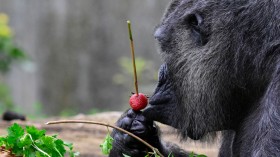Researchers in Africa have observed two similar grazing animals adopt markedly different feeding habits during periods of drought.
The gemsbok, a type of gazelle found in Africa, was documented surviving during periods of drought by eating high quantities of poisonous plants. The behavior is striking when compared to similar animals such as the springbok antelope, which survives through drought by feeding on every type of plant material it can find but avoiding poisonous plants.
"We wanted to understand how these quite well-studied ungulates with contrasting feeding strategies can survive and even flourish in an adverse habitat like the Kunene region in Namibia, where the environment is characterized by strong and unpredictable variation in resource availability," said David Lehmann, doctoral candidate at the German Leibniz Institute for Zoo and Wildlife Research (IZW) and lead author of the study.
When conditions are good the gemsbok, also known as an oryx, feeds on seasonal succulent plants as well as grass.
But during drought periods, the researchers found that gemsbok will switch its eating patterns to include as much as 25 percent of Damara milk-bush, a succulent plant plentiful year round which is also highly toxic.
Springbok, in contrast, avoided the toxic plant but fed on a higher proportion of bushes and tree foliage rather than the grasses and succulents it prefers.
"The potential effects of the Damara milk-bush on gemsbok health are still unknown. However, by extensively using this poisonous plant, gemsbok succeed in surviving environmental challenges," the researchers wrote in a statement. "Gemsbok seem to be well adapted to the toxic effects of special plants growing in dry regions, and they benefit from their high water and nutritious content."
The researchers contend that global climate change will increase drought periods and enhance desertification in Southern Africa, therefore, how wildlife species respond to their environment and the decline of food sources will be important to understand.
Additionally, the researchers wrote, both the gemsbok and the springbok are important food sources themselves, providing essential protein and nutrients to local communities, which would be negatively affected by a declining population of the animals.
A better understanding of the animals' feeding behaviors is essential to establishing sustainable wildlife management plans, the researchers said.
Lehmann and his colleagues' research is published in the journal PLOS One.
© 2024 NatureWorldNews.com All rights reserved. Do not reproduce without permission.
![Great White Sharks Observed for the First Time Changing Their Behavior in Different Marine Environments [Study]](https://1471793142.rsc.cdn77.org/data/thumbs/full/70251/280/157/50/40/great-white-sharks-observed-for-the-first-time-changing-their-behavior-in-different-marine-environments-study.jpg)




